#peat bogs
Explore tagged Tumblr posts
Text
#article#Yale environment#climate change#climate crisis#farming#peat bogs#europe#germany#co2 emissions
60 notes
·
View notes
Text
Rewetting about half of England’s lowland peat would be enough to deliver a fifth of the greenhouse gas emissions savings needed from the country’s farming by 2030, research suggests. Rewetting peat would also help restore habitats for birds, wildlife and plant species.
131 notes
·
View notes
Text
European Oak-Worship
“We have seen that long before the dawn of history Europe was covered with vast primaeval woods, which must have exercised a profound influence on the thought as well as on the life of our rude ancestors who dwelt dispersed under the gloomy shadow or in the open glades and clearings of the forest" (p. 350).
“When Hatfield Moss [a peat-bog] in Yorkshire was drained, there were found in it trunks of oak a hundred feet long and as black as ebony. One giant actually measured a hundred and twenty feet in length, with a diameter of twelve feet at the root and six feet at the top. No such tree now exists in Europe" (p. 351).

Peat-bog above Fossdale Gill in Yorkshire (pictured in 2015).
(Source: Peat bog above Fossdale Gill by Ian Taylor, CC BY-SA 2.0 https://creativecommons.org/licenses/by-sa/2.0, via Wikimedia Commons)
“The evidence of classical writers proves that great oak forests still existed down to their time in various parts of Europe. Thus the Veneti on the Atlantic coast of Brittany made their flat-bottomed boats out of oak timber, of which, we are told, there was abundance in their country. Pliny informs us that, while the whole of Germany was covered with cool and shady woods, the loftiest trees were to be seen not far from the country of the Chauci, who inhabited the coast of the North Sea. Among these giants of the forest he speaks especially of the oaks which grew on the banks of two lakes. When the waves had undermined their roots, the oaks are said to have torn away great portions of the bank and floated like islands on the lakes" (p. 353).

The North Sea. (Source: photo © by Tomasz Sienicki [user: tsca, mail: tomasz.sienicki at gmail.com], CC BY 2.5 https://creativecommons.org/licenses/by/2.5, via Wikimedia Commons)
“...[Pliny] speaks of the vast Hercynian wood of Germany as an oak forest, old as the world, untouched for ages, and passing wonderful in its immortality. So huge were the trees, he says, that when their roots met they were forced up above ground in the shape of arches, through which a troop of horse could ride as through an open gate" (p. 354).

Map depicting the Hercynian Forest, by Christopher Weigel (1718).
(Source: Christopher Weigel, CC BY-SA 4.0 https://creativecommons.org/licenses/by-sa/4.0, via Wikimedia Commons)
"...with the Druids the growth of mistletoe on an oak was a sign that the tree was especially sacred; and the rarity of this feature—for mistletoe does not commonly grow on oaks—would enhance the sanctity and mystery of the tree. For it is the strange, the wonderful, the rare, not the familiar and commonplace, which excites the religious emotions of mankind.... Thus among the Celts of Gaul the Druids esteemed nothing more sacred than the mistletoe and the oak on which it grew; they chose groves of oaks for the scene of their solemn service, and they performed none of their rites without oak leaves. ‘The Celts,’ says a Greek writer, ‘worship Zeus, and the Celtic image of Zeus is a tall oak’"" (p. 358; p. 362).

Druid Cutting Mistletoe on the 6th Day of the Moon (c. 1900), by Henri-Paul Motte
(Source: Henri-Paul Motte (1846-1922), Public domain, via Wikimedia Commons)
"Perhaps the oldest and certainly one of the most famous sanctuaries in Greece was that of Dodona, where Zeus was revered in the oracular oak. The thunder-storms which are said to rage at Dodona more frequently than anywhere else in Europe, would render the spot a fitting home for the god whose voice was heard alike in the rustling of the oak leaves and in the crash of thunder” (p. 358).

Zeus of Dodona wearing oak wreath (obverse of silver distaster from c. 295-272 BCE, reign of Epeiros, King Pyrrhos; London, British Museum).
(Source: ArchaiOptix, CC BY-SA 4.0 https://creativecommons.org/licenses/by-sa/4.0, via Wikimedia Commons)
“On the rivulet Micksy, between the governments of Pskov and Livonia in Russia, there stood a stunted, withered, but holy oak, which received the homage of the neighbouring peasantry down at least to 1874. An eyewitness has described the ceremonies. He found a great crowd of people, chiefly Esthonians of the Greek Church, assembled with their families about the tree, all dressed in gala costume. Some of them had brought wax candles and were fastening them about the trunk and in the branches. Soon a priest arrived, and, having donned his sacred robes, proceeded to sing a canticle, such as is usually sung in the Orthodox Church in honour of saints. But instead of saying as usual, ‘Holy saint, pray the Lord for us,’ he said, ‘Holy Oak Hallelujah, pray for us.’ Then he incensed the tree all round. During the service the tapers on the oak were lighted, and the people, throwing themselves on the ground, adored the holy tree. When the pastor had retired, his flock remained till late at night, feasting, drinking, dancing, and lighting fresh tapers on the oak, till everybody was drunk and the proceedings ended in an orgy[!]” (pp. 371-372).
—J. G. Frazer, The Magic Art & the Evolution of Kings, part 2 (The Golden Bough, vol. II, 1911, pp. 350-372)

Old oak tree near Ungurmuiža Manor in modern-day Latvia.
(Source: Ainars Brūvelis, CC BY-SA 3.0 https://creativecommons.org/licenses/by-sa/3.0, via Wikimedia Commons)
#oak#oak tree#peat bogs#yorkshire#veneti#chauci#north sea#folklore#hercynian forest#druids#mistletoe#celts#gaul#sacred grove#zeus#dodona#oracular oak#greece#micksy#pskov#livonia#russia#estonia#greek orthodox#jg frazer#the golden bough#the golden bough vol ii
3 notes
·
View notes
Text

[Peat] consists of Sphagnum moss along with the roots, leaves, flowers and seeds of heathers, grasses and sedges. Occasionally the trunks and roots of trees such as Scots pine, oak, birch and yew are also present in the peat. (walter-us.net)
54 notes
·
View notes
Text
@alackofghosts adds this which should not have been left in tags.

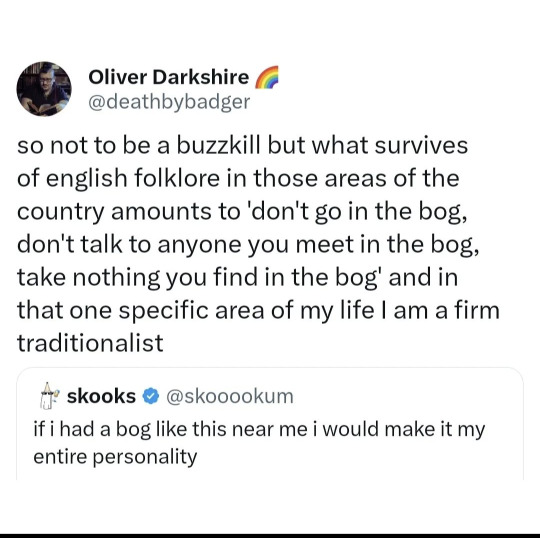

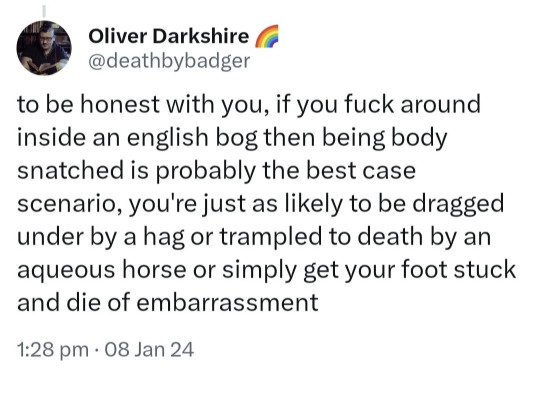
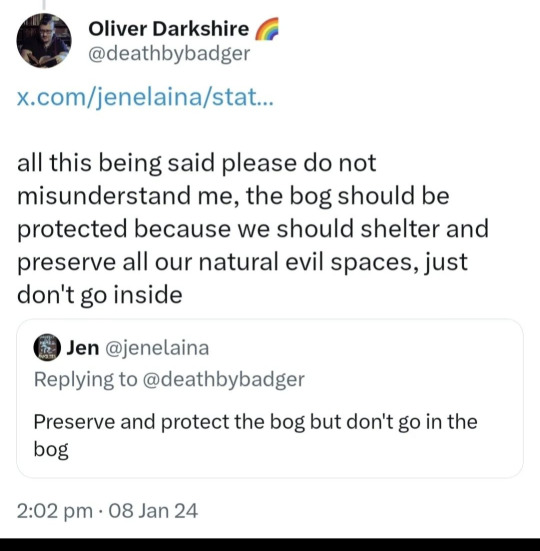

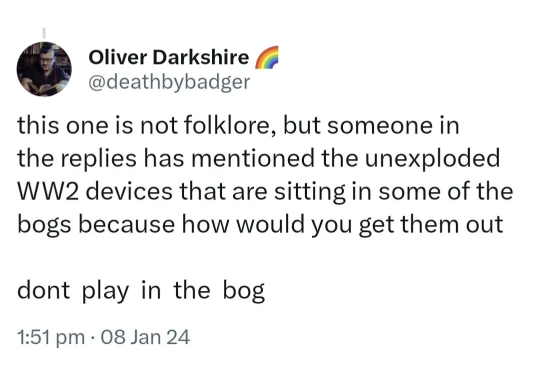
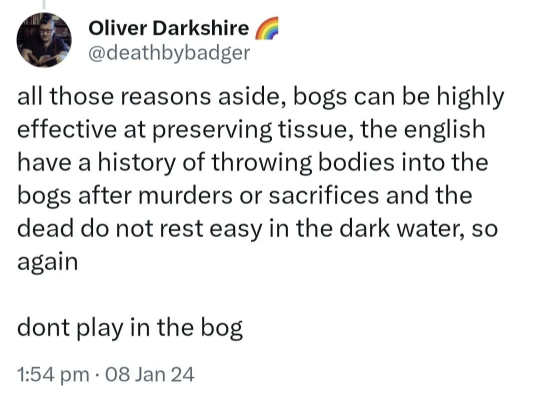

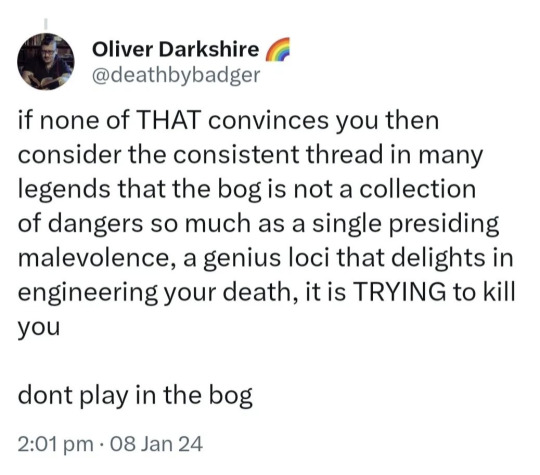

63K notes
·
View notes
Text

Subscribe to my brand new Beautiful Noise Substack for 2025 to document the unfolding of my next album Mosses. https://beautifulnoise.substack.com/
#substack#beautiful noise#tinyleaves#music#ecology#conservation#peat bogs#neoclassical#ambient#landscape#field recording#birdsong
0 notes
Text

Lindow Man 1st Century CE 'Bog Body', The British Museum, London
Lindow Man is a well-preserved human body found in a peat-bog at Lindow Moss, near Manchester, in 1984. He died a violent death, sustaining many injuries before he was placed face down in a pool in the bog.
He was about 25 years old, 1.7m (5ft 6ins) tall and weighed 60-65kg (9.5-10st).
He had done very little hard, manual work, because his fingernails were well manicured.
His beard and moustache had been cut by a pair of shears.
His last meal probably included unleavened bread made from wheat and barley, cooked over a fire on which heather had been burnt.
#bog body#lindow man#prehistoric#prehistory#iron age#ritual#peat bog#archaeology#ancient cultures#ancient living#preservation#British Museum#human
118 notes
·
View notes
Text
Choose your own adventure comic, poll below!

As you stand on the vast moorland, near where the hills end and the bog starts, your mind rushes with anticipation. Today, you are going to RAISE THE DEAD!!!
… More specifically, you’re going to try necromancy on some dead frogs. You’ve been practicing for months, and now that you’re 12 years old, you feel like you should at least be able to make small animal skeletons move.
First, you’ll need to find some bones.
All you need to do is search the large, carnivorous pitcher plants and sundews that grow in the area. There are a lot of plants, so it would be easier if you had someone to help you search. This is where your pet golem, Pete, will come in handy. You like to mold him into a different shape every time you remake him.
This collaborative choose-your-own-adventure comic is called Codex Calluna. A new page will be posted every Saturday evening (est). If you would like to, reblogs mean more people will be able to see this and participate!
Archive blog with only the comic pages: here
#codexcalluna#codex calluna#webcomic#comic#comics#medieval fantasy#medieval#cyoa#choose your own adventure#poll#tumblr polls#cyoa game#cyoa poll#poll game#polls#soil#dirt#necromancy#necromancer#oc#oc art#medieval art#peat#bog#sphagnum
156 notes
·
View notes
Text
Is the difference between a swamp and a bog the location (geographic & linguistic) or the physical composition??
#I'm using you instead of Google so I can have some friends for a few glorious seconds#Is a bog mostly peat??? Vs a swamp being not quite that yet???#So the difference may actually be time????
29 notes
·
View notes
Text
Happy Bogust everyone!!

81 notes
·
View notes
Text
ROUND 3: 1925 TRISTATE TORNADO (sky) VS SPHAGNUM MOSS (bog)

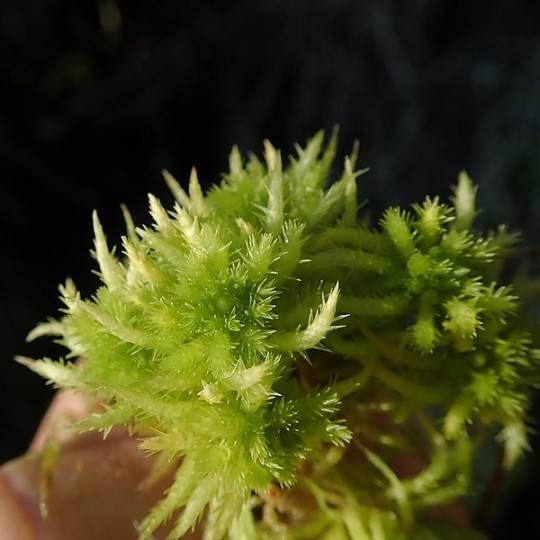
#tournament#now kill#i hope this is the right moss this time T-T#f3#tornado#moss#sphagnum moss#sphagnum#bog#peat bog#smack barm peat wet
405 notes
·
View notes
Text
Discovered in a peat bog 150 years ago, the Orkney Hood is the only complete item of fabric clothing to have survived from early medieval Scotland. Made between AD250 and 615 and held by @NtlMuseumsScot via @Dark Ages on twitter More: https://northages.wordpress.com

22 notes
·
View notes
Text
Solarpunk Sunday Suggestion:
Educate yourself about the importance of peatland and mangrove ecosystems
#solarpunk#hopepunk#environmentalism#cottagepunk#social justice#community#optimism#bright future#climate justice#tidalpunk#lunarpunk#turbinepunk#ecosystem restoration#carbon sinks#mangroves#peat#wetlands#bog#coast#solarpunksundays
76 notes
·
View notes
Text
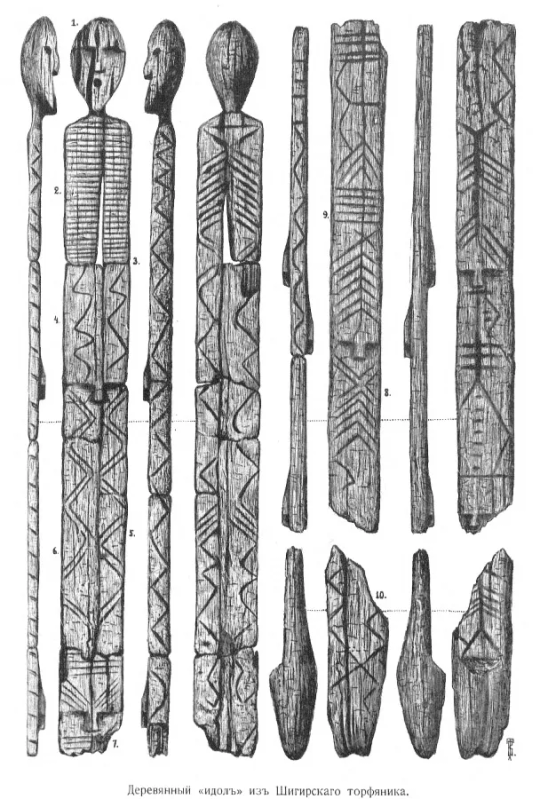
#The oldest known wood carved sculpture in the world#the Shigir idol#was carved by Mesolithic hunter-gatherers in today’s Russia some 11000 years ago. Found in 1890#on a depth of 4 meters in a peat bog in Shigir#Middle Urals.#Drawings by: Vladimir Tolmachev
29 notes
·
View notes
Text
grass isn't enough i need to touch peat bog
21 notes
·
View notes
